ANEURYSM Clinical presentation, Diagnosis and Anaesthetic management
ANEURYSM Clinical presentation, Diagnosis and Anaesthetic management. Dr. Girija Rath Dr. Divya Dr. Abhijit. www.anaesthesia.co.in anaesthesia.co.in@gmail.com. Intracranial Aneurysms. Most common cause of subarachnoid haemorrhage Types - Saccular, Fusiform, Dissecting
Share Presentation
Embed Code
Link
Download Presentation
- schwartz rb et al
- cause
- ruptured aneurysm sah
- meningeal irritation
- antifibrinolytic therapy increase incidence
- mostly sporadic

kina + Follow
Download Presentation
ANEURYSM Clinical presentation, Diagnosis and Anaesthetic management
An Image/Link below is provided (as is) to download presentation Download Policy: Content on the Website is provided to you AS IS for your information and personal use and may not be sold / licensed / shared on other websites without getting consent from its author. Content is provided to you AS IS for your information and personal use only. Download presentation by click this link. While downloading, if for some reason you are not able to download a presentation, the publisher may have deleted the file from their server. During download, if you can't get a presentation, the file might be deleted by the publisher.
Presentation Transcript
- ANEURYSMClinical presentation, Diagnosis and Anaesthetic management Dr. Girija Rath Dr. Divya Dr. Abhijit www.anaesthesia.co.inanaesthesia.co.in@gmail.com
- Intracranial Aneurysms • Most common cause of subarachnoid haemorrhage • Types - Saccular, Fusiform, Dissecting • Size – Small 24 mm (2%) • 50 – 80% don't rupture
- Epidemiology • Prevalence of Intra cranial aneurysms – 1-5% adult population • Incidence of SAH from rupture of Intra cranial aneurysms - 1 / 10,000 persons • Ruptured Aneurysm - 75- 85% case of SAH
- Epidemiology (cont.) • Risk of SAH - 2 times more in woman • Peak incidence in 55- 60 yrs • SAH – high mortality and morbidity (2 of 3 survive to receive medical t/t; 1 of 3 receiving t/t will be severely disabled or die)
- Associated conditions • Mostly sporadic lesions • Rare familial form has also been described • Associated conditions – autosomal dominant polycystic kidney disease, fibromuscular dysplasia, Ehler – danlos syndrome , AV malformations of brain, coactation of aorta • Smoking and hypertension - ↑ risk • Vascular abn. – Type 3 collagen deficiency
- Pathogenesis • Acquired vascular lesions secondary to degenerative changes in vessel wall • Hypertension and smoking induced vascular changes – major predisposing role • Common histological finding - ↓ tunica media in middle muscular layer of artery
- Distribution • occur at vascular branching points • most centered around the circle of Willis • 20-30% are multiple, and often mirror • usually rupture at the dome
- Distribution Anterior circulation (85%) • ACA complex incl. Anterior Communicating (AComm) & pericallosal artery • MCA bi-/trifurcation • Internal Carotid Artery (esp at origin of PComm, ophthalmic, anterior choroidal, or terminus) Posterior Circulation (15%) • basilar tip • also PICA
- Distribution
- Clinical presentation of Aneurysm • Most common presentation - Subarachnoid haemorrhage • Silent - incidental finding on investigations • Symptomatic – d/t mass effect cranial nerve palasies ( 3 nerve palasy in PCA aneurysm) brain stem compression
- Natural History of Aneurysm • Ruptured aneurysms – greater chance of future rupture • Unruptured aneurysms - 1-2 % per year risk of rupture Exceptions • symptomatic aneurysms, size > 10 mm, • aneurysms of basilar apex or PCA • Coexisting or remaining aneurysms of all sizes in pts with H/O SAH ( AHA Recommendations for the Management of unruptured Intracranial Aneurysms – 2001)
- Pathophysiology of Aneurysm Rupture • Rupture aneurysm initial increase in ICP decrease in CBF and CPP immediate change in the level of consciousness • The dramatic reduction of CBF is a major factor halting the subarachnoid bleeding.
- Pathophysiology of Aneurysm Rupture (cont.) Two distinct cerebral hemodynamic patterns are seen • Gradual reduction in ICP increase in CBF over approx.15 min improvement of cerebral function. Clinically patients present with varying levels of consciousness. • Persistent increase in ICP resulting in failure of recovery of both CBF and functional activity. Clinically these pts. die before receiving treatment or have persistent vegetative state.
- Clinical Features of Ruptured Aneurysm/SAH Neurological • Headache - severe ("worst in my life!") • often transient loss of consciousnessat onset (due to abrupt rise in ICP) • Signs of meningeal irritation – neck stiffness • Nausea & Vomiting, photophobia, altered mentation • Focal Deficits – sensory, motor, visual
- Clinical Features of SAH (cont.) Cardiovascular - ECG changes – 50 to 80% • Prolongation of the Q-T interval, ST and T wave changes, P wave changes, U waves, and dysrythmias including VT & VF • Usually during first 48 hrs. Normalise in 10 days • Cause mostly Neurogenic – SAH related injury to the posterior hypothalamus stimulate release of norepinephrine from the adrenal medulla and sympathetic cardiac efferent (Stroke 1991;22:746-9.) • 27 -33% - ventricular wall dysfunction • D/D - electrolyte disturbances, Myocardial ischemia/ infarction
- Grading of SAH -Modified Hunt and Hess
- World Federation of Neurological Surgeon’sGrading Scale - WFNS GradeGCSMotor Deficit • I 15 Absent • II 13-14 Absent • III 13-14 Present • IV 7-12 +/- • V 3-6 +/-
- Diagnostic Studies • Non contrast CT • Lumbar puncture • MRI • Angiography
- Noncontrast CT • Procedure of choice for confirming diagnosis of SAH • CT - magnitute and location of SAH probable location of aneurysm ventricular size • Prospective series of 100 patients with suspected SAH 100% within 48 hrs 85% after 5 days 50% after 1 week 30% after 2 weeks Van Gijn et al. Time course of aneurysmal hemorrhage on CT Neuroradiology 23 : 1985
- Fisher Grading Base on the amt and distribution of SAH blood on NCCT Predicts the probability of developing delayed ischaemia d/t vasospasm • 1 No subarachnoid blood detected • 2 Diffuse or vertical layers < 1 mm thick • 3 Localized clot and/or vertical layer >1 mm • 4 Intracerebral or intraventricular clot with diffuse or no subarachnoid blood
- Nonenhanced CT
- Lumbar puncture • Before advent of CT, only modality available • Reserved for 5% patients with negative CT • False positive d/t traumatic tap • xanthochromia (yellow color) is more sensitive sign than bloody CSF (appears after 4 hrs , negative after 3 weeks) • Dangerous in patients with raised ICP - risk of brain herniation and aneurysm rebleeding
- MRI • Magnetic resonance imaging is not well suited for imaging SAH in the acute stage • After several days or weeks, when the CT scan has normalized, MRI may detect subpial hemosiderin close to the source of the rupture.
- Cerebral angiography • Gold standard for identifying aneursyms • 4 vessel angiogram should be performed as soon as possible after the diagnosis of SAH to identify etiology (aneursym rupture 75 -85%) • Presence of multiple aneurysm (incidence 5%-33.5%)
- CT angiography • noninvasive modality • In aneurysms > 3 mm sensitivity 90 – 95% specificity 100% Harrison MJ et al. neurosurg 40 : 1997
- MRA – Magnetic resonance angiography • Probably the best noninvasive modality to detect etiology of SAH • In aneurysms > 3 mm sensitivity 91 – 96% specificity 100% (Schwartz RB et al. radiology 192 : 1994) • More useful in patients with angio negative SAH renal failure contrast c/i
- CT Angiogram
- Screening for Asymptomatic Aneurysms Screening with MRA is indicated • for people who have two immediate relatives with Intra cranial aneurysm • for all patients with autosomal dominant polycystic kidney disease An estimated 5 to 40 percent of patients with autosomal dominant polycystic kidney disease have intracranial aneurysms
- Complications of Ruptured aneurysm/SAH • Symptomatic vasospasm • Rebleeding • Hydrocephalus • Seizures • Hyponatremia • The leading causes of death and disability after SAH are direct effect of the initial bleed, cerebral vasospasm, and rebleeding.
- Radiological vasospasm 60% of patient 2. Clinical vasospasm (DIND > - 30% of patients - CBF < 20 mL / 100 g/ min as measured by PET Vasospasm
- Arterial narrowing demonstrated on cerebral angiography Previous scans helpful Only larger artery narrowing can be visualized angiographically Radiographic vasospasm
- Clinical vasospasm / symptomatic vasospasm • Characterized by delayed focal ischemic neurologic deficit • C/F include alterations in consciousness such as drowsiness and disorientation, or transient focal neurologic deficits • increasing headache, meningismus, fever, and tachycardia.
- Time course of vasospasm • Onset – after day 3 • Peak incidence – 7 th day < 4 – 14 days >• Rare after 2 wks • Antifibrinolytic therapy increase incidence
- Mechanism of Vasospasm Subarachnoid blood Hb & oxy Hb Superoxide radicals ↓ NO production & inactivation of NO ↑ Protein kinase C insmoth ms cells Release of Intracellular Calcium Myofilament activation Vasospasm J Neurosurg1990;72:634-40
- Diagnosis of vasospasm • Cerebral angiography - gold standard” for diagnosis of cerebral vasospasm Smooth, luminal narrowing of involved arteries • Trans cranial doppler – safe, repeatable, noninvasive method Velocities > 200 cm/s; associated with high risk of vasospasm; velocities < 100 cm/s; pts are unlikely to have clinical vasospasm (Neurosurgery 1988;23: 598-604)
- Prevention of vasospasm • Calcium Channel Blockers - Cochrane Reviews 2007, Issue3 • Calcium antagonists (oral nimodipine) reduces the risk of poor outcome and secondary ischaemia after aneurysmal SAH. The evidence for other calcium antagonists( eg. Nicardipine) is inconclusive. • Oral nimodipine is currently indicated in patients with aneurysmal SAH. Intravenous administration of calcium antagonists cannot be recommended for routine practice on the basis of the present evidence. • Magnesium sulphate is a promising agent but more evidence is needed before definite conclusions can be drawn.
- Prevention of vasospasm (conti.) 2. Removal of Spasmogenic Substances • Early surgical removal of cisternal blood clot within 96 h of SAH prevents the development of vasospasm.
- Treatment of Vasospasm • Nimodipine - 60mg q4h x 3 weeks Evidence-based cerebral vasospasm management - Neurosurg. Focus / Volume 21 / September, 2006 Cochrane Reviews 2007, Issue 3 • Triple HHH therapy • Balloon Angioplasty • Pharmacological dilatation
- Triple H therapy Rationale – CBF autoregulation is impaired in the ischaemic area and thus CBF becomes perfusion dependent. Hypervolemia • Fluids : NS ± Albumin : Target CVP – 10 mmHg or PAWP – 12 -20 mmHg Hypertension • Dopamine, Dobutamine, Phenylephrine • max target sys BP 160 -200 mmHg after clipping of aneurysm or 120 -150 mmHg if aneurysm is not clipped Hemodilution • Usually results from hypervolumic therapy • Target hematocrit: 3O - 35% • Transfuse for Hct < 25% The end-point of hypertensive/hypervolemic therapy is reached when neurologic deficits resolve or when complications of therapy ensue.
- Complications of Triple H therapy 1 Intracranial • May exacerbate cerebral edema / ↑ ICP • May produce hemorrhagic infarction in an area of previous ischemia 2 Systemic • Pulmonary edema (7 -17%) • Dilutional hyponatremia (3 -35%) • MI (2%) • Coagulopathy (3%)
- Triple H therapy • No large randomized trial demonstrating efficacy, but strong evidence from uncontrolled series to support that triple H therapy improves symptomatic ischemia and reduces morbidity and mortality • There is less evidence to support the use of prophylactic hypervolemic hypertensive therapy for prevention of symptomatic vasospasm. (REVIEW ARTICLE MCGRATH ET AL.POSTOPERATIVE MANAGEMENT OF SUBARACHNOID HEMORRHAGE ANESTH ANALG 1995;81:1295-302)
- Treatment of vasospasm (cont.) Balloon angioplasty • Advocated for patients in whom symptoms persist despite maximum hypervolemic /hypertensive therapy • The risks of angioplasty include aneurysm rupture, intimal dissection, vessel rupture, ischemia, and infarction
- Treatment of vasospasm (cont.) Direct pharmacological arterial dilatation • Intra arterial papaverine infusion for cerebral vasospasm after SAH (American Journal of Neuroradiology, Vol 16, Issue 1 27-38) Side effects – thrombocytopenia, ↑ICP, transient brain stem dysfunction, hypotension , monocular blindness • Endothelin receptor antagonists eg Clazosentan Randomized, double-blind, placebo-controlled, multicenter phase IIa study- Reduces the frequency and severity of cerebral vasospasm following severe aneurysmal SAH J Neurosurg. 2005 Jul;103(1):9-17.
- Complications of SAH (cont.) Rebleeding • Max frequency on 1st day – 4% • Thereafter, 1.5% on subsequent days • Cumulative risk - 19% rebleed in 14 days & 50% rebleed in 6 months
- Strategies to reduce rebleeding • Conservative management of ruptured aneurysm - high incidence of rebleeding • Only definitive method is obliteration of the aneurysm. • Antifibrinolytic agents (tranexamic acid and EACA) • significantly decreased the incidence of rebleeding in comparison to placebo, but did not decrease mortality (Clin Neurosurg 1986;33:137-45.) • proportional increase in mortality from ischemic neurologic deficits by increasing vasospasm
- Strategies to reduce rebleeding Rebleeding rate is higher if systolic BP > 160 mm Hg Therapy to avoid increase in transmural pressure (MAP- ICP) • Bed rest • Treatment of hypertension from pain and anxiety • Intravenous lidocaine during endotracheal suctioning. • Short-acting hypotensivc drugs (esmolol, labetolol, or nitroprusside) for control of labile hypertension or transient hypertension. • Stool softeners are given to reduce abdominal straining.
- Complications of SAH (cont.) Hydrocephalus -25% 1. Acute obstructive hydrocephalus Due to blood obstructing the ventricular drainage pathway 2. Chronic communicating hydrocephalus Due to pia-arachnoid adhesions or permanent impairment of arachnoid granulations T/t – Ventricular drainage/ VP shunt
- Complications of SAH (cont.) Seizures - 13% after SAH and 40% of those with a neurologic deficit • indicate rebleeding or rarely vasospasm • as the risk of rebleeding increases during seizure, prophylactic administration of a anticonvulsant is recommended in the immediate posthemorrhage period
- Complications of SAH (cont.) Hyponatremia (l0%-34%) • 3 – 5 days after SDH • Traditionally attributed to SIADH & was treated by fluid restriction • Etiology - Cerebral “salt wasting” d/t hypothalamic dysfunction and secretion of ANP (Cerebral Salt Wasting Syndrome: A Review.Neurosurgery. 38(1):152-160, January 1996.) • T/t - Fluid & salt replacement
- Initial Treatment Plan after Aneurysmal ruptureSurgical VS. Conservative Nonoperative management should be confined to • poor-grade patients who are not expected to tolerate a surgical procedure, or • patients in Hunt and Hess Grades IV and V, in whom operative mortality is as high as 75% (Acta Neurochir (Wien) 1993;122:1-10 .) Load More .

Shoulder problems and Clinical Diagnosis
Today's programme. Clinical anatomy of shoulderShoulder painImpingement
955 views • 70 slides

Improving Clinical Diagnosis
2. . An example of Evidence-Based Clinical Medicine The aim of this exercise is to illustrate how epidemiological techniques could be used to help the physician improve his clinical diagnosis. .. Improving Clinical Diagnosis. 3. Reader's Tasks. What is the hypothesis and rational justifying th
748 views • 52 slides
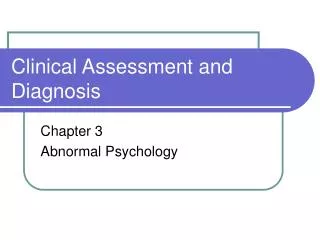
Clinical Assessment and Diagnosis
Clinical Assessment and Diagnosis. Chapter 3 Abnormal Psychology. Clinical Assessment. Protocols used for evaluation and measurement Assessing/diagnosing psychological disorders. Getting Started. What brings the client to the provider?
641 views • 24 slides
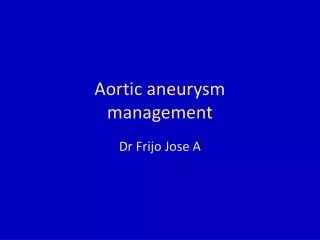
Aortic aneurysm management
Aortic aneurysm management. Dr Frijo Jose A. TA Aneurysm. Essentials of Diagnosis Asc Ao diameter > 4 cm on imaging study Desc Ao diameter > 3.5 cm on imaging study. Asc Ao aneurysms – 3 common patterns. Crawford classification - aneurysm in desc Ao and thoracoabdominal Ao.
1.36k views • 61 slides
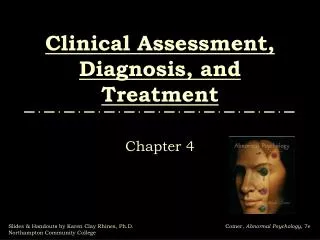
Clinical Assessment, Diagnosis, and Treatment
Clinical Assessment, Diagnosis, and Treatment. Chapter 4. Clinical Assessment: How and Why Does the Client Behave Abnormally?. Assessment is collecting relevant information in an effort to reach a conclusion
931 views • 56 slides
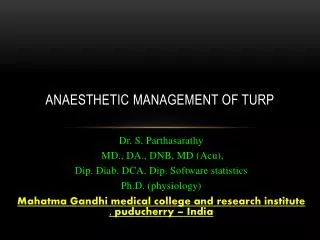
AnAesthetic management of TURP
AnAesthetic management of TURP. Dr . S. Parthasarathy MD., DA., DNB, MD ( Acu ), Dip. Diab . DCA , Dip. Software statistics Ph.D. (physiology ) Mahatma Gandhi medical college and research institute , puducherry – India . How common . Approximately 40 000 transurethral resections
3.43k views • 44 slides
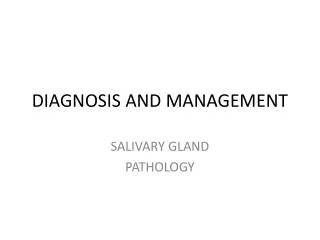
DIAGNOSIS AND MANAGEMENT
DIAGNOSIS AND MANAGEMENT. SALIVARY GLAND PATHOLOGY. Salivary gland pathology, he guarantees you will see this in your practice. We will talk on benign as well as malignant disease and management. . There are 6 major salivary glands; there are 6 because they are paired.
1.2k views • 86 slides

Clinical Presentation and Diagnosis of Tuberculosis
Clinical Presentation and Diagnosis of Tuberculosis. Your name Institution/organization Meeting Date. International Standards 1-5. Clinical Presentation and Diagnosis of TB. Objectives: At the end of this presentation, participants will be able to:
1.29k views • 50 slides

DIAGNOSIS AND MANAGEMENT
DIAGNOSIS AND MANAGEMENT. SALIVARY GLAND PATHOLOGY. DISTRIBUTION OF MINOR SALIVARY GLANDS. Palate 60% Tongue 10% Lips 10% Cheeks 10% Retromolar 10%. TONGUE GLANDS (LINGUAL). Inferior apical—glands of Blandin Nuhn (mucous secretion) Taste buds—vonEbner’s glands (serous secretion)
1.09k views • 70 slides

Clinical diagnosis
Clinical diagnosis. Dr. B.S. Vishwanath Professor, DOS in Biochemistry University of Mysore Mysore. Easy diagnosis Right treatment Increased life span Better quality life. Biased opinion Viewed as business rather than service Expensive Room for exploitation Results in legal issues.
1.68k views • 68 slides
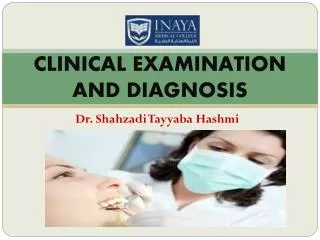
CLINICAL EXAMINATION AND DIAGNOSIS
CLINICAL EXAMINATION AND DIAGNOSIS. Dr. Shahzadi Tayyaba Hashmi. CLINICAL EXAMINATION. Clinical examination: It includes both extra oral and intra oral examination. ORAL EXAMINATION AND DIAGNOSIS. Intra oral examination Hard tissue and soft tissue examination Extra oral examination
1.05k views • 21 slides
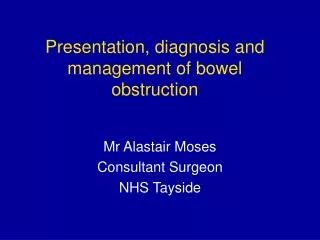
Presentation, diagnosis and management of bowel obstruction
Presentation, diagnosis and management of bowel obstruction. Mr Alastair Moses Consultant Surgeon NHS Tayside. Pathophysiology. Any part of the GI tract may become obstructed and present as an acute abdomen. Dilatation of bowel proximal to obstruction with air and fluid.
749 views • 32 slides
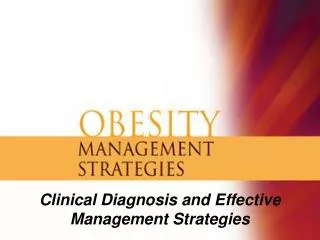
Clinical Diagnosis and Effective Management Strategies
Clinical Diagnosis and Effective Management Strategies. What Do We Know About Obesity. Prevalence continues to rise at alarming rate among adults, children and adolescents. Most common medical problem seen in primary care office. Is a major cause of preventable death.
632 views • 44 slides

Clinical Presentation and Diagnosis of Tuberculosis
Clinical Presentation and Diagnosis of Tuberculosis Slides from the web site http://www.tbrieder.org Compiled by: Hans L Rieder. Background of stained smears. Acid-alcohol destained smear. Sulfuric acid destained smear.
1.38k views • 117 slides

Clinical and radiological presentation and diagnosis
Clinical and radiological presentation and diagnosis. David W. Denning National Aspergillosis Centre University Hospital South Manchester [Wythenshawe Hospital] University of Manchester. The National Aspergillosis Centre. 225-250 new patients with aspergillosis referred annually.
956 views • 73 slides

Clinical Assessment and Diagnosis
Clinical Assessment and Diagnosis. Chapter 4. IntroducTION.
590 views • 33 slides

CLINICAL ASSESSMENT AND DIAGNOSIS
CLINICAL ASSESSMENT AND DIAGNOSIS. Basics of Clinical Assessment. Multimethod & Multimodal. Like a Funnel. Start Broad. More Specific. Determining the Value of Clinical Assessment. Value Depends On. Reliability
638 views • 29 slides

Cerebral Aneurysm: Anesthetic Management
Cerebral Aneurysm: Anesthetic Management. Moderator Dr. Girija Rath Presenter Dr. Abhijit Laha. www.anaesthesia.co.in anaesthesia.co.in@gmail.com. Pre-operative Evaluation & Preparation. Assess the neurological status & SAH grade:
989 views • 54 slides

Clinical Presentation and Diagnosis
Clinical Presentation and Diagnosis in Pulmonary Hypertension Due To Recurrent Pulmonary Thromboembolism Numan EKİM MD. Gazi University School of Medicine Chest Diseases Department. Recurrent pulmonary thromboembolism. Epidemiology and risk factors -1
529 views • 34 slides

Metabolic Alkalosis causes, clinical features, diagnosis, and management.
Metabolic Alkalosis causes, clinical features, diagnosis, and management. Alex Yartsev Derived largely from Brandis. The concept of pH. pH = - log 10 aH + Where aH + is the activity of the H + ion at the glass electrode in the ABG machine
1.53k views • 23 slides

Clinical and radiological presentation and diagnosis
Clinical and radiological presentation and diagnosis. David W. Denning National Aspergillosis Centre University Hospital South Manchester [Wythenshawe Hospital] University of Manchester. The National Aspergillosis Centre. 225-250 new patients with aspergillosis referred annually.
870 views • 73 slides

Clinical Diagnosis and Effective Management Strategies
Clinical Diagnosis and Effective Management Strategies. What Do We Know About Obesity. Prevalence continues to rise at alarming rate among adults, children and adolescents. Most common medical problem seen in primary care office. Is a major cause of preventable death.
466 views • 44 slides
























